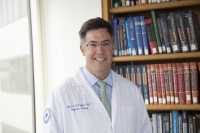18 May Efficient Protocol Allows Primary Stroke Centers To Ensure Access To Thrombectomies
MedicalResearch.com Interview with:
Ryan A. McTaggart M.D.
Assistant Professor of Diagnostic Imaging, Neurology, and Neurosurgery
@mobilestroke4U
Warren Alpert School of Medicine
Brown University
Rhode Island Hospital
MedicalResearch.com: What is the background for this study?
Response: Stroke is the #1 cause of disability and 5th leading cause of death. Mechanical thrombectomy (direct mechanical removal of the obstructing blood clot) is a dramatically effective treatment for the most devastating of all acute ischemic strokes – emergency large vessel occlusion (ELVO).
Access to this treatment can be optimized with the use of
1) mobile stroke unit technology,
2) changing our Emergency medical services triage algorithms so that stroke matches that of trauma (using field severity to transport the right patient, to the right hospital, the first time, whenever possible), and
3) improving in-hospital processes at Primary Stroke Centers (PSCs) so that patients with suspected ELVO who present to a PSC (a hospital that does not offer mechanical thrombectomy) do not get left behind and untreated.
This study reflects an effort to address and improve the third item.
MedicalResearch.com: What are the main findings?
Response: The main finding of this study is that a standardized in-hospital protocol for patients with suspected ELVO presenting to a PSC (a hospital that does not offer 24/7 endovascular coverage) consisting of: early CSC notification, CT Angiography (CTA) at the PSC and electronic image sharing prior to transfer is associated with dramatic clinical benefits to patients with the most devastating form of ischemic stroke.
When all three aspects of the protocol are executed for these patients, time from PSC arrival to reperfusion at the CSC is almost one hour less compared to when all three aspects are not performed, and patients were twice as likely to be independent at 90 days. This process can be easily replicated between PSC and CSC partners/pairs, even without formal telestroke relationships.
MedicalResearch.com: What should readers take away from your report?
Response:
Endovascular-capable comprehensive stroke centers (CSCs) and PSCs must partner together (regardless of the financial entity to which they belong) to ensure all patients achieve timely access to mechanical thrombectomy. In so doing, the non-endovascular capable centers (PSCs) must perform the following key steps in parallel when a patient with clinical suspicion for ELVO arrives at their center:
- Emergency room physicians or ancillary staff assess potential stroke patients immediately on arrival to PSC, and call the CSC if the patient’s Los Angeles Motor Score (LAMS) score is >4. This is before any imaging has been done.
- Following this phone call, the CSC critical care transport team is dispatched. If the CSC transport team is unavailable, the PSC can make alternate arrangements to have a transport team ready prior to confirmation of LVO on brain CTA. The mantra here is “Waste gas not brain”.
- If LAMS score is >4, the PSC obtains CTA at time of initial Non-contrast head CT (NCCT), and ideally within 30 minutes of PSC arrival.
- Send images via a secure, HIPAA compliant cloud based platform for immediate and remote viewing by the CSC stroke team.
- Direct transport to the CSC angiography suite on all confirmed ELVO patients.
MedicalResearch.com: What recommendations do you have for future research as a result of this study?
Response: While larger prospective studies are needed to confirm our findings, the treatment effect for these patients is so profound that practical improvements in the efficiency of the stroke care seem warranted immediately. Vessel imaging with CTA at the PSC is imperative for patients with suspicion for ELVO. Door in Door out (DIDO) time, similar to door-to-needle (DTN) time for intravenous tPA must become a key metric for PSC efficiency and should now become standard metric for care delivery at all non-endovascular capable hospitals.
No disclosures.
MedicalResearch.com: Thank you for your contribution to the MedicalResearch.com community.
Citation::
Note: Content is Not intended as medical advice. Please consult your health care provider regarding your specific medical condition and questions.
More Medical Research Interviews on MedicalResearch.com
[wysija_form id=”5″]
Last Updated on May 18, 2017 by Marie Benz MD FAAD

